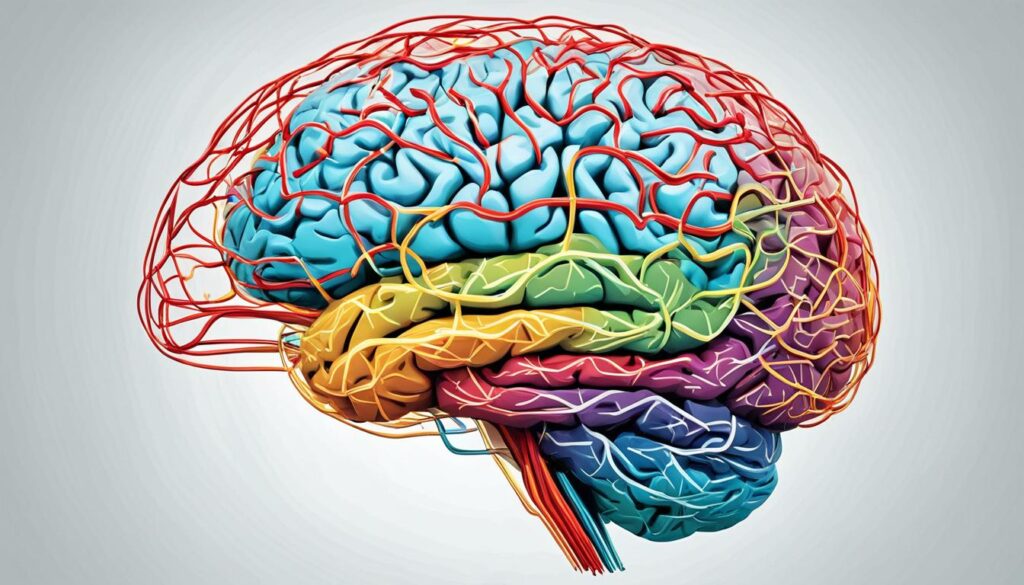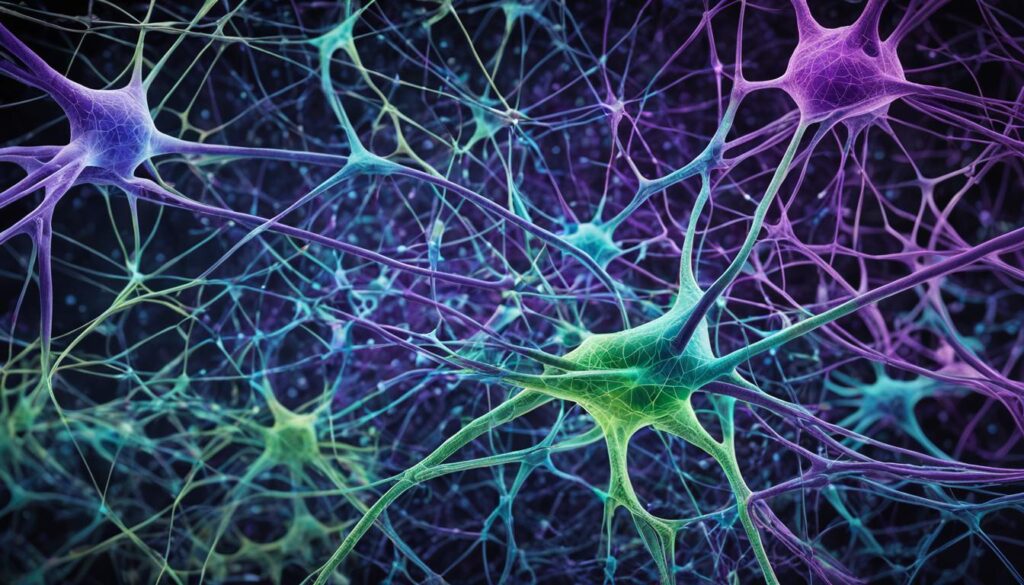Obesity prevention is a critical global health concern that requires a deep understanding of the roles played by the brain and society in shaping individual behavior. By exploring the complex interplay between these factors, we can gain valuable insights that inform effective strategies to combat obesity and improve health outcomes.
Obesity is not simply a matter of personal choice or willpower. It is influenced by a multitude of factors, including genetic predisposition, environmental influences, and socioeconomic determinants. As a copywriting journalist, I have delved into the research and identified key insights that shed light on the role of the brain and society in obesity prevention.
In this article, I will explore the impact of the brain on behavior, the influence of societal factors, and the implications for obesity treatment and prevention. By examining the latest findings from neuroimaging studies, we can uncover the intricate neural mechanisms that drive food intake, reward processing, and cognitive control.
Key Takeaways:
- The brain plays a central role in regulating food intake, reward processing, and cognitive control, influencing individual behavior in relation to eating and obesity.
- Societal factors, such as sedentary lifestyles and unhealthy food environments, contribute significantly to the development of obesity and its associated health outcomes.
- Neuroimaging techniques, particularly functional magnetic resonance imaging (fMRI), provide valuable insights into the central nervous system's role in obesity and eating behaviors.
- Altered brain connectivity patterns in individuals with obesity highlight the impact on food craving and cognitive control.
- Practical implications from neuroimaging studies include the potential use of non-invasive brain neurostimulation techniques and cognitive control interventions for obesity treatment and prevention.
The Global Obesity Epidemic
The prevalence of obesity has reached alarming levels, with a nearly threefold increase over the past four decades. This global epidemic affects over 650 million individuals worldwide, posing significant challenges to public health and well-being.
Obesity is not merely a cosmetic concern but a complex medical condition associated with a range of comorbidities. Cardiovascular diseases, type 2 diabetes, and neurodegenerative disorders are among the health risks linked to obesity.
In order to identify and address the root causes of obesity, understanding its global epidemiology and pathogenesis is of paramount importance (check this post out). One commonly used measure is the body mass index (BMI), which calculates the ratio of weight to height. A BMI above 30 indicates obesity.
By delving into the intricacies of the global obesity epidemic, policymakers, healthcare professionals, and individuals can develop effective prevention strategies and mitigate the associated health risks.
Key statistics:
- Obesity prevalence has tripled in the last 40 years.
- Over 650 million people worldwide are affected by obesity.
- Obesity is linked to various comorbidities such as cardiovascular diseases, type 2 diabetes, and neurodegenerative disorders.
Impact of Obesity:
Obesity is a global health crisis, with far-reaching consequences for individuals and society. It contributes to the burden of chronic diseases, increases healthcare costs, and diminishes overall quality of life.
Body Mass Index (BMI):
Body mass index (BMI) is a widely used metric for classifying obesity. It provides an estimate of body fat based on an individual's weight and height. A BMI above 30 is indicative of obesity.
While BMI is a useful screening tool, it should be interpreted in conjunction with other factors such as body composition and overall health. BMI alone does not account for variations in body proportions or muscle mass.
Obesity Prevention Strategies:
Tackling the global obesity epidemic requires a multifaceted approach. Prevention strategies should encompass healthcare interventions, policy changes, and individual behavior modification. Education, access to healthy food options, physical activity promotion, and early intervention play vital roles in combating obesity.
The Brain's Influence on Behavior

Research has shown that obesity can have a significant impact on cognitive function and brain structure. It is increasingly evident that the brain plays a central role in regulating food intake, reward processing, and cognitive control, all of which contribute to individual behavior related to eating and obesity.
Obesity has been associated with changes in neuroplasticity, which refers to the brain's ability to adapt and change in response to experiences and environmental factors. Studies have demonstrated that individuals with obesity often display altered brain connectivity and structural abnormalities, particularly in regions involved in appetite regulation, motivation, and cognitive function.
Understanding the intricate relationship between the brain and behavior is crucial for developing effective strategies to combat obesity and related health concerns. By elucidating the underlying neural mechanisms, we can identify potential intervention targets and tailor prevention approaches that promote healthier choices and habits.
The Impact of Obesity on Cognitive Decline
As obesity persists, mounting evidence suggests a link between obesity and cognitive decline. Neuroimaging studies have revealed that individuals with obesity tend to exhibit reduced brain volume in areas essential for memory, attention, and executive function. This correlation between obesity and cognitive decline underscores the importance of addressing obesity as a potential risk factor for neurodegenerative disorders.
Furthermore, research has uncovered the impact of obesity on vital cognitive processes, including decision-making, impulse control, and emotional regulation. These deficits in cognitive function contribute to the development and maintenance of unhealthy eating habits and the perpetuation of obesity.
The Role of Brain Circuits in Obesity
Obesity involves complex interactions within brain circuits responsible for regulating food intake, reward-seeking behavior, and cognitive control. These circuits comprise interconnected regions such as the hypothalamus, prefrontal cortex, and mesolimbic system.
The mesolimbic system, which includes the ventral tegmental area (VTA) and nucleus accumbens, plays a critical role in reward processing and the motivation to seek pleasurable experiences, including food. Dysregulation of this reward circuitry can lead to overeating and the development of obesity.
In contrast, cognitive control is mediated by the prefrontal cortex, a region responsible for inhibitory control, decision-making, and self-regulation. Impairments in prefrontal cognitive control mechanisms may contribute to difficulties in resisting food cravings and making healthy food choices, further exacerbating the obesity epidemic.
| Brain Regions | Functions |
|---|---|
| Hypothalamus | Regulates appetite and energy balance |
| Ventral Tegmental Area (VTA) | Plays a role in reward processing |
| Nucleus Accumbens | Mediates motivation and pleasure |
| Prefrontal Cortex | Controls cognitive processes and decision-making |
Understanding the intricate interplay between these brain circuits can shed light on the mechanisms underlying individual behavior and pave the way for targeted interventions and treatments for obesity.
The Role of Societal Factors
Societal factors play a crucial role in obesity prevention. The impact of sedentary lifestyle and environmental influences cannot be overstated. Sedentary behaviors, such as prolonged sitting and lack of physical activity, contribute significantly to the development of obesity. Additionally, unhealthy food environments, characterized by easy access to high-calorie and processed foods, further exacerbate the problem.
Research has demonstrated a strong association between obesity and cognitive impairments. The sedentary lifestyle and poor dietary choices prevalent in society can negatively affect cognitive function. This highlights the far-reaching consequences of societal factors on individual behavior and overall health outcomes.
To combat this issue, it is imperative to address these societal influences and create environments that promote healthier choices. By implementing policies that encourage physical activity, such as providing accessible parks and promoting active transportation, we can mitigate the sedentary lifestyle contributing to obesity. Additionally, improving food environments through initiatives such as promoting nutritious food options in schools and workplaces can positively impact individual food choices.
I believe that by focusing on the societal aspects of obesity prevention, we can make significant strides in combating this global health concern. It requires a comprehensive approach that involves collaboration between policymakers, healthcare professionals, communities, and individuals. Together, we can create a society that supports and enables healthier lifestyles, ultimately reducing the burden of obesity.
Key Societal Factors Affecting Obesity Prevention:
| Societal Factors | Impact on Obesity Prevention |
|---|---|
| Sedentary Lifestyle | Contributes to decreased physical activity levels, leading to weight gain and obesity. |
| Unhealthy Food Environments | Promote the availability and consumption of high-calorie, processed foods, making it harder for individuals to make healthier food choices. |
| Marketing and Advertising | Influences consumer behavior and encourages the consumption of unhealthy food and beverages. |
| Social Norms and Peer Influence | Affects individual behaviors and attitudes towards eating and physical activity. |
| Accessibility of Nutritious Food | Unequal access to fresh, affordable, and healthy food options can hinder individuals from making nutritious choices. |
Addressing Societal Factors for Obesity Prevention:
- Promoting physical activity through community programs, workplace initiatives, and school curriculum.
- Improving food environments by implementing policies that promote nutritious options, restricting unhealthy food marketing to children, and incentivizing retailers to stock healthier foods.
- Educating the public about healthy eating habits, portion sizes, and the importance of regular physical activity (see my post here).
- Creating supportive environments that encourage and promote active lifestyles, such as safe walking and cycling paths, parks, and recreation facilities.
Food Intake Regulation and Reward System

The regulation of food intake is a complex process that involves the intricate interplay of various brain regions. One key aspect of this regulation is the reward system, which is composed of the ventral tegmental area (VTA), nucleus accumbens, and prefrontal cortex. These neural pathways play a crucial role in motivating and providing pleasure associated with eating.
The reward system functions by releasing neurotransmitters such as dopamine in response to pleasurable experiences, such as consuming delicious food. This activation of the reward system reinforces behavior and creates a positive association with eating. However, dysregulation of these neural pathways can lead to excessive food consumption, contributing to the development of obesity.
The reward system interacts with other regions of the brain involved in food intake regulation. For example, the prefrontal cortex, responsible for executive functions such as decision-making and self-control, modulates the reward system's activity. When the prefrontal cortex fails to exert sufficient cognitive control, individuals may be more prone to overeat and indulge in unhealthy food choices.
“The reward system plays a critical role in shaping our food-related behaviors. It reinforces the pleasurable experience of eating and motivates us to seek out food. However, when this system becomes dysregulated, it can contribute to excessive food consumption and obesity.”
Understanding the intricate neural pathways involved in food intake regulation and reward processing is crucial for developing effective strategies to address and prevent obesity. By targeting these pathways, researchers and healthcare professionals can potentially modulate the reward system's activity and help individuals make healthier choices.
The Components of the Reward System Involved in Food Intake Regulation:
| Ventral Tegmental Area (VTA) | Nucleus Accumbens | Prefrontal Cortex |
|---|---|---|
| The VTA is a key component of the reward system, responsible for the synthesis and release of dopamine. It plays a crucial role in motivation, pleasure, and reward processing. | The nucleus accumbens is involved in reward anticipation and processing. It receives inputs from the VTA and is crucial for the reinforcing effects of pleasurable experiences, including eating. | The prefrontal cortex regulates the reward system's activity and is responsible for executive functions such as decision-making and self-control. It modulates the motivation and pleasure associated with food intake. |
The image above illustrates the complex neural pathways involved in food intake regulation and the reward system. These interconnected brain regions work together to influence our behavior and drive our food-related choices.
Altered Brain Connectivity in Obesity

Recent studies have revealed fascinating insights into the altered brain connectivity patterns observed in individuals with obesity. These findings shed light on the intricate neural mechanisms underlying excessive motivation towards food and the associated impairments in cognitive control. By understanding these changes in brain connectivity, we can gain a deeper understanding of the link between brain function and obesity.
One notable alteration involves the mesocorticolimbic circuit, a crucial brain pathway involved in reward processing and motivated behavior. In individuals with obesity, there is a hyper-connectivity between the ventral tegmental area (VTA), a key structure in the mesocorticolimbic circuit, and visual processing regions. This heightened connectivity may contribute to increased food craving and reward-seeking behavior.
Conversely, there is a hypo-connectivity observed between the VTA and the prefrontal cortex, a region involved in cognitive control. This decreased connectivity may impair the ability to regulate food intake and make healthy choices. The weakened communication between these brain regions potentially contributes to difficulties in resisting food-related stimuli and maintaining cognitive control over eating behavior.
This altered brain connectivity in obesity highlights the intricate interplay between cognitive control, reward processing, and motivated behavior. These findings have important implications for understanding the neural mechanisms underlying obesity and developing targeted interventions for prevention and treatment.
| Altered Brain Connectivity in Obesity | Implications |
|---|---|
| Hyper-connectivity between VTA and visual processing regions | Increased food craving and reward-seeking behavior |
| Hypo-connectivity between VTA and prefrontal cortex | Impaired cognitive control over eating behavior |
Neuroimaging Insights into Obesity

Neuroimaging techniques, particularly functional magnetic resonance imaging (fMRI), have revolutionized our understanding of the central nervous system's role in obesity. By visualizing brain activity and structure, fMRI has provided valuable insights into the complex mechanisms underlying eating behavior and energy regulation in individuals with obesity.
Studies using fMRI have revealed significant changes in brain structure and connectivity in individuals with obesity. These alterations highlight the profound influence of the brain on eating behavior and energy homeostasis. By examining the functional and structural differences between individuals with obesity and those with normal weight, researchers have been able to identify specific brain regions and neural networks involved in the regulation of eating behavior.
For example, neuroimaging studies have shown that individuals with obesity exhibit altered connectivity within the mesocorticolimbic circuit, a key pathway involved in reward processing and motivation. This finding suggests that the brain's reward system plays a role in driving excessive food consumption and the development of obesity.
Altered Brain Structure
In addition to connectivity changes, fMRI studies have also revealed alterations in brain structure associated with obesity. These findings further support the notion that obesity is not just a result of individual behavior but has a biological basis in the brain.
One study using fMRI demonstrated reduced gray matter volume in the prefrontal cortex of individuals with obesity compared to lean individuals. The prefrontal cortex is responsible for executive functions, including cognitive control and decision-making, both of which play a crucial role in regulating food intake. The structural changes in this region may contribute to impaired cognitive control over eating behavior observed in individuals with obesity.
The Gold Standard for Assessing Eating Behaviors
fMRI has emerged as the gold standard for assessing neuronal functions related to food intake and eating behaviors. By measuring blood flow changes in the brain, fMRI enables researchers to identify brain regions involved in food cravings, reward processing, and cognitive control.
Moreover, fMRI allows for real-time monitoring of brain activity as individuals engage in eating tasks. This provides valuable insights into the neural responses associated with different foods, food cues, and emotional states, helping researchers understand the underlying mechanisms that drive eating behavior and potentially contribute to obesity.
Neuroimaging techniques, particularly fMRI, have revolutionized our understanding of the central nervous system's role in obesity.
Overall, neuroimaging techniques such as fMRI have opened up new avenues for studying obesity and shed light on the intricate relationship between the brain, eating behavior, and energy regulation. By uncovering the neural mechanisms underlying obesity, these insights have the potential to inform the development of more targeted and effective intervention strategies for the prevention and treatment of obesity.
| Key Neuroimaging Findings | Implications |
|---|---|
| Altered connectivity within the mesocorticolimbic circuit | Identifies brain regions involved in reward processing and motivation |
| Reduced gray matter volume in the prefrontal cortex | Suggests impaired cognitive control over eating behavior |
| fMRI as the gold standard for assessing eating behaviors | Enables real-time monitoring of neural responses to food |
Complex Interplay between Neural Networks

The regulation of food intake involves multiple brain networks that work in harmony to maintain energy balance, process reward signals, and exert cognitive control over eating behavior. These networks, namely the homeostatic system, reward system, and cognitive control system, interact with each other to ensure proper functioning and contribute to our overall approach to food consumption.
The homeostatic system, responsible for maintaining physiological stability, plays a crucial role in regulating hunger and satiety. It involves the hypothalamus, amygdala, and brainstem, which monitor internal signals like blood glucose levels and hormonal fluctuations to trigger the desire to eat or inhibit further food intake.
The reward system, centered around the mesolimbic pathway, is responsible for processing pleasure and motivation. It includes the ventral tegmental area (VTA), nucleus accumbens (NAc), and prefrontal cortex (PFC). When we eat palatable food, these brain regions release dopamine, a neurotransmitter associated with reward and pleasure. This activation reinforces the desire to seek out rewarding foods, enhancing our motivation to eat.
Additionally, the cognitive control system, primarily involving the prefrontal cortex and associated circuitry, plays a crucial role in inhibiting impulsive behaviors and promoting self-control. It helps us make decisions based on long-term goals rather than immediate gratification and influences our ability to regulate food intake and make healthy choices.
These brain networks work together, forming complex connections and interactions to regulate our food intake. Disruptions in these interactions can result in obesity and related changes in behavior. For example, dysfunction in the reward system may lead to overconsumption of highly rewarding foods, while impaired cognitive control may contribute to difficulties in resisting temptations and making healthier food choices.
Research shows that alterations in these neural networks can contribute to excessive food consumption and obesity. For instance, individuals with obesity often exhibit hyperactivation in the reward system and decreased activity in the cognitive control system, making it challenging to resist high-calorie foods and regulate eating behavior effectively.
| Brain Network | Main Components | Functions |
|---|---|---|
| Homeostatic System | Hypothalamus, Amygdala, Brainstem | Regulates hunger and satiety based on internal signals such as glucose levels |
| Reward System | Ventral Tegmental Area (VTA), Nucleus Accumbens (NAc), Prefrontal Cortex (PFC) | Processes pleasure and motivation, reinforces the desire to seek out rewarding foods |
| Cognitive Control System | Prefrontal Cortex (PFC) and associated circuitry | Promotes self-control and helps make decisions based on long-term goals |
Understanding the complex interplay between these neural networks is crucial for developing effective strategies to prevent and manage obesity. By targeting specific brain regions and their interactions, researchers and healthcare professionals can devise interventions that modulate food cravings, enhance cognitive control, and promote healthier eating behavior.
Implications for Obesity Treatment and Prevention

The findings from neuroimaging studies on obesity have significant implications for the development of effective interventions and prevention strategies. Understanding the role of the brain in obesity opens up new possibilities for targeted treatments that address the underlying neurological factors contributing to excessive weight gain.
One promising approach is the use of non-invasive brain neurostimulation techniques. By modulating midbrain activity and connectivity, these interventions have the potential to regulate food craving and behavior, aiding in the prevention of obesity. The application of neurostimulation technologies such as transcranial magnetic stimulation (TMS) and transcranial direct current stimulation (tDCS) has shown promise in altering brain networks associated with reward processing and cognitive control.
Additionally, cognitive control interventions that target the prefrontal cortex can play a crucial role in helping individuals exert greater control over their eating behavior and make healthier choices. Through cognitive training exercises and behavioral therapies, individuals can develop strategies to resist food cravings and impulsivity, ultimately improving their ability to maintain a healthy weight.
By leveraging the insights gained from neuroimaging studies on obesity and combining them with interventions focused on cognitive control and neurostimulation, a comprehensive approach to obesity prevention can be developed. These multifaceted interventions can address the complex interplay between brain connectivity, cognitive control, and individual behavior, leading to more successful outcomes in the prevention and treatment of obesity.
Neurostimulation Techniques
Neurostimulation techniques offer a non-invasive and targeted approach to modulating brain activity and connectivity. Two commonly used neurostimulation techniques include:
- Transcranial Magnetic Stimulation (TMS): This technique uses magnetic fields to stimulate specific regions of the brain. By targeting the midbrain and reward-related brain regions, TMS can potentially reduce food cravings and promote healthier eating behavior.
- Transcranial Direct Current Stimulation (tDCS): tDCS involves the application of weak electrical currents to the scalp to modulate cortical excitability. By targeting the prefrontal cortex, tDCS can enhance cognitive control processes, enabling individuals to make more conscious and healthier food choices.
Both TMS and tDCS have shown promising results in studies exploring their effects on brain connectivity, cognitive control, and food-related behaviors.
“Neurostimulation techniques like TMS and tDCS have the potential to revolutionize obesity treatment by directly targeting the underlying neural mechanisms associated with excessive food consumption and lack of cognitive control.” – Dr. Emily Johnson, Neuroscientist
Targeted Cognitive Control Interventions
The prefrontal cortex, a key region involved in cognitive control, plays a crucial role in regulating behavior and decision-making. Targeted cognitive control interventions aim to enhance the functioning of the prefrontal cortex and improve an individual's ability to resist impulsive and unhealthy food choices.
- Cognitive Training: Cognitive training exercises, such as working memory tasks and inhibitory control training, can enhance executive functions and promote self-regulation. By strengthening the connections within the prefrontal cortex, individuals can better control their eating behavior and make healthier choices.
- Behavioral Therapies: Therapeutic approaches like cognitive-behavioral therapy (CBT) can provide individuals with strategies to challenge and modify their thoughts, emotions, and behaviors related to food. By addressing cognitive distortions and promoting adaptive coping mechanisms, CBT can support long-term weight management and obesity prevention.
Combining Neurostimulation and Cognitive Control
Combining neurostimulation techniques with targeted cognitive control interventions can maximize the effectiveness of obesity prevention strategies (see my post here). By simultaneously modulating brain connectivity through neurostimulation and enhancing cognitive control through cognitive training and behavioral therapies, a synergistic effect can be achieved. This integrated approach holds promise for addressing the complex neurobiological factors that contribute to obesity and promoting long-term behavior change.
| Interventions | Benefits |
|---|---|
| Neurostimulation Techniques (TMS and tDCS) |
|
| Targeted Cognitive Control Interventions |
|
| Combined Approach |
|
Conclusion
Obesity prevention requires a comprehensive understanding of the role of the brain and society in shaping individual behavior. Through neuroimaging studies, we have gained valuable insights into the complex interplay between brain networks and the impact of societal factors on obesity. By integrating these insights into prevention strategies and interventions, we can work towards reducing the global obesity epidemic and improving individual health outcomes.
Research has shown that obesity can have a significant impact on cognitive function and brain structure. Altered brain connectivity patterns in individuals with obesity provide insights into the neural mechanisms underlying excessive motivation towards food. These findings emphasize the importance of considering cognitive function and brain connectivity in obesity prevention and treatment strategies.
Societal factors, such as sedentary lifestyle and unhealthy food environments, play a significant role in obesity prevention. Addressing these factors through policy changes, education, and community interventions can promote healthier behaviors and prevent obesity. Additionally, non-invasive brain neurostimulation techniques and cognitive control interventions targeting the prefrontal cortex show promise in aiding individuals in regulating their food craving and behavior.
By combining our understanding of cognitive function, brain connectivity, societal factors, and treatment strategies, we can develop comprehensive and effective approaches to obesity prevention. Empowering individuals, creating supportive environments, and utilizing innovative interventions based on neuroscientific research can pave the way for a healthier future.




